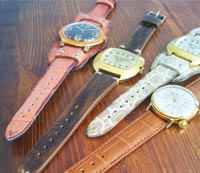Today this nearly forty-year old, Arezzo-based company, which produces GPF straps (from the initials of the company owner, Gian Pietro Failli) in exotic leathers, is channelling its long-established experience into the world of footwear, with the new Failli 1979 Tuscany collection. We met with brand manager, Lorenzo Pitirra, during their debut exhibition at THEMicam tradeshow in Milan.
From watch straps to footwear. How did this happen and what do you think your very specific expertise can bring to the sector?
 Even though we are obviously presenting a new brand, after our vast experience in the production of leather watch straps, it was only natural for us to progress into the footwear sector. Our know-how in the art of working exotic leathers is characteristic for the meticulous attention to detail, an element that is very typical of the watch sector. These shoes are made with alligator leather; we only use the sides of the snake, because it’s softer that the underbelly and the scales are more detailed. Not only have we created a concept for the footwear range, we have also created one for the packaging. When you buy a watch it often comes in an elegant box, with a guarantee and care instructions. So we decided to use this idea in the footwear: Failli 1979 Tuscany shoes are presented in a wooden box, lined with a velvety fabric with leather inserts, an instruction booklet and an international guarantee (translated into 11 languages), together with information on the origins of leathers materials. We also had the idea of using steel for the eyelets; the octagonal shape is inspired by the case of a watch, echoing the meticulous workmanship. These eyelets are composed of two parts that are screwed together using a special mechanism, which also creates an elegant, screw-shaped incision.
Even though we are obviously presenting a new brand, after our vast experience in the production of leather watch straps, it was only natural for us to progress into the footwear sector. Our know-how in the art of working exotic leathers is characteristic for the meticulous attention to detail, an element that is very typical of the watch sector. These shoes are made with alligator leather; we only use the sides of the snake, because it’s softer that the underbelly and the scales are more detailed. Not only have we created a concept for the footwear range, we have also created one for the packaging. When you buy a watch it often comes in an elegant box, with a guarantee and care instructions. So we decided to use this idea in the footwear: Failli 1979 Tuscany shoes are presented in a wooden box, lined with a velvety fabric with leather inserts, an instruction booklet and an international guarantee (translated into 11 languages), together with information on the origins of leathers materials. We also had the idea of using steel for the eyelets; the octagonal shape is inspired by the case of a watch, echoing the meticulous workmanship. These eyelets are composed of two parts that are screwed together using a special mechanism, which also creates an elegant, screw-shaped incision.
Your footwear is certainly striking; can you tell me a little bit more about it?
First of all, I would like to underline the Tuscan origins of the products, which are all made and crafted in the Arezzo area. This applies not only to the materials of the footwear, but also all the other accessories in the box, like the walnut shoe trees with alligator and steel appliques; the walnut shoehorn, the natural rubber and horse hair brushes, the cleaning kit and so on. For now, the collection consists of three models that are not influenced by the fashion seasons. There’s the ‘Da Vinci’ ankle boot, the ‘Bolgheri’ moccasin and the new British-style, ‘Salimbeni’ lace-up design, which has a very refined finish, with a heel and welt covered in alligator leather. It takes an entire day to make each shoe. 80% of the work is carried out by hand, with the fringe, heel cap and upper come in different colours and a vast array of shades combinations and small bespoke touches, including a hand sewn internal label with the name of the owner and date of purchase. Our next project will be the creation of a luxury sneaker, which would fit naturally into the current product range. Our greatest desire is for the public to slowly discover the details of the footwear, getting to know the shoe through learning about our history. We are proud of our origins; what we do is a genuine philosophy of life.
What type of client does your brand focus on?
Our shoes are definitely dedicated to people who love beautiful items in every form; a client who knows how to choose and appreciate ‘Made in Italy’ luxury. We decided to detach ourselves from the seasonality and the need to constantly chase after the next trend. In this sense, we’re inspired by classic watches, objects of an innate, unique and timeless elegance. These are ‘evergreen’ products with a whimsical edge, which is also given by the coloured alligator skin accents. This said, our reference market is definitely the Far East – I’m thinking Korea and Japan – but also Russia and Europe. At the moment we’re focusing our efforts on promoting the brand at select events and venues, but most of all we want to convey our typically Tuscan, artisanal passion for the art of footwear.



